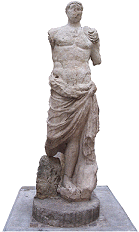THE LEGEND OF PEPEZUC

That is the statue we can find at the bottom of the Française's street, on the square which got his name, not far from the place where, until the XVII-th century, was a monumental Roman fountain decorated with a colossal 2,75 meters statue representing an Apollo - drawn in the Anne de Rulman's manuscript (1610).
Pépézuc would represent the Roman emperor "Tetricus son" (end IIIrd century) who was nominated to repair the Domitian way. It is an imperial statue from Roman time "with exchangeable head" (the last head would have been lost in Montpelier in 1587).
Legendary personality, Biterrois hero by excellence, he is the figure of the City's defender against invaders.
During the Caritachs' celebrations, at the Middle Age, the statue was dressed with gold-coloured paper, a three-cornered hat and mustaches were painted on his face with pieces of coal. Until the XIX-th, Pépézuc get an enormous phallus, such as gives evidence this lady Bigorne's poem in 1615 :
Je vous ai vu dans ma jeunesse (During my youth I saw you)
Plein de vigueur et d'allégresse.(Full of elation and vigour)
Bien mieux : vous portiez en ce temps, (Much better : you wore at this time)
Là devant ces bien beaux pendants, (Such beautiful pendants in front of my eyes)
Si utiles aux courtisanes, (So useful for courtesans they are)
Comme aux cloches l'est leur battant (As to ring bells a maul is required).
Note : I tried to translate this poem using rhymes - OK, I know it's not very good but I hope you'll like it...
All corporations, walking through the Française's street, tilted alternately their banners in front of him. Then women and children danced crazily all around in shouting : Viva Pépézuc !
During this time, multiple plays were played on the Citadel's theatre (click to see some plays -only in French- format PDF - 4,8 Mo).
The original, made of a very beautiful white marble, is inside the Biterrois Museum (without head, of course).
The statue had to measure a little more than two meters: his height and the draperies in which he is dressed presumes the representation of a god, a hero or an emperor.
First allusion about him appears in Mascaro's XIV-th chronicles : "The Black Death erupts in 1348, near the Tarboriech's house, trader, close to Pierre Péruc who stays at the end of the Française's street".
Pierre Andoque says that in 1357 the bishop Hugues de Rieux and the seneschal Arnaud de Montespan approved the election of a military chief named "Monpézuc", who already had bravely defended the city against the English.
According to Rulman, in 1628, an Hercule's statue, called by the vulgar, "Pierre Pézuc", is at the entrance of the Française's street.
So, in the course of time, the statue was called "Pierre Pézuc", "Pierre Péruc", "Monpézuc" and then "Pépézuc".
Doubtless because of inscriptions on the statue's pedestal : IMP. P. ESV (translated this day by "Imperator Pius Esuvius)